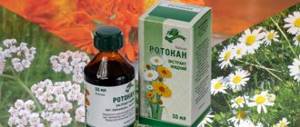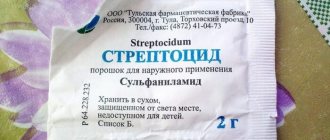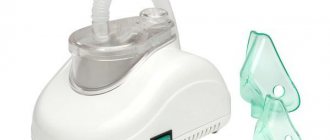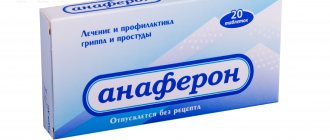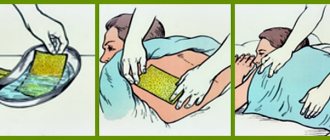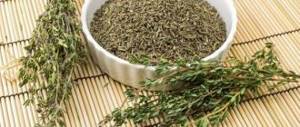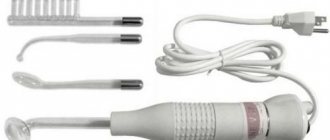Streptocide for the throat is one of the most common medicines that are quite effective against bacterial inflammation. The required amount of the drug, frequency and duration of administration should be determined by the doctor depending on the disease, the severity of the patient’s condition, his age and other characteristics. Streptocide is an antibiotic that belongs to the group of sulfonamides. This is due to its therapeutic effect, which includes not only the fight against pathogens, but also the reduction of inflammatory changes.
Before using the drug, you should consult a specialist, as this drug can have a toxic effect on various organs, especially the liver. Streptocide is contraindicated in patients with diseases of this organ - severe complications may develop when taking the medicine.
In this article we will look at in what cases this remedy should be taken, when it is contraindicated, in what dosages it is used, and also what analogues exist.
When is streptocide prescribed?
Streptocide is indicated for the treatment of many inflammatory diseases of the throat and oropharynx associated with the addition of a bacterial infection. This antibiotic has a wide spectrum of action, which includes all the most common bacteria that cause diseases of the ENT organs and diseases of other systems.
This drug is indicated for the following diseases:
- sore throat (tonsillitis);
- other bacterial lesions of the oropharynx;
- stomatitis and ulcers of the oral mucosa;
- intestinal infections;
- suppuration of wounds;
- burns;
- erysipelas;
- inflammatory pathologies of the urinary tract.
Streptocide is used not only in the form of tablets, but also in the form of powder and ointments. The dosage form is determined by the pathology that needs to be cured. For example, for a sore throat, tablets are used, and for purulent complications of wounds, ointments are required.
Precautionary measures
- During long-term treatment with streptocide, it is necessary to monitor the condition of the liver and kidneys, as well as regularly check the blood.
- Streptocide should be prescribed with caution to people with kidney disease.
- During therapy you need to drink plenty of fluids.
- Do not reduce the dosage or interrupt the course of treatment, as this may provoke the development of infection resistance to sulfonamides.
- The use of streptocide for the treatment of ulcerative tonsillitis is contraindicated.
- Please note that streptocide is included in many sprays and aerosols for sore throat. If you have ever had an allergy to a drug, carefully read the composition of such medications.
Blister of Streptocide
Directions for use and dosage
Before use, the physician should assess the sensitivity of the bacterial flora to sulfonamides. This can be done both on the basis of clinical data and as a result of bacteriological examination of the discharge.
The dosage for adults is usually 0.5 to 1 g 5 times a day. The maximum daily dose for adults is 7 grams, a single dose is 2 grams. In children, the required amount of the drug is determined by their age and severity of the disease.
For sore throat, streptocide is used in the form of tablets, which must be crushed into powder before use. At the initial stage of the disease, it may be enough to take one single dose at night in the form of powder mixed with honey. If the disease is really just beginning, then by morning the symptoms should disappear.
If the manifestations of the pathology bother the patient for 24 hours or more, or the above method did not prove effective, then streptocide powder is applied to the affected tonsils. Do not swallow saliva for 10 minutes so that the active substance can be absorbed into the diseased tissue. After this time, you need to spit out the powder and rinse your mouth with a disinfectant. Repeat this procedure several times every 2 hours.
At the same time, you need to drink plenty of fluids and stay in bed - this will help speed up the healing process.
Features of using Streptocide in powder form - instructions, reviews, recipes
Streptocid powder is prescribed for the treatment of infectious and inflammatory diseases in children and adults. The article contains instructions, features of use, recipes for “talkers”, analogues of the drug. The information presented is provided for informational purposes only. The product can be used after individual medical consultation.
Description of the drug
Streptocide is a broad-spectrum antimicrobial drug. It suppresses the vital activity of staphylococcus, streptococcus, gonococcus, and other gram-negative and gram-positive microbes of the coccal group. The antibacterial agent also inhibits the activity of Toxoplasma, Shigella, Escherichia coli, Clostridia, Chlamydia, measles, and malaria pathogens.
The medicine does not affect viruses. Therefore, the use of the drug is not advisable for herpes, flu, ARVI, colds, and similar infections.
Form and composition of the drug
Medicines are prepared for systemic and local action. Pharmacies sell five types of the drug. Names and dosage forms:
- White streptocide – powder in sachets/bottles of 2 g, 5 g, 10 grams;
- Streptocide – tablets 0.3 g, 0.5 g;
- Streptocide ointment 10% – in tubes/jars of 25 g, 30 g, 50 g;
- Soluble streptocide – liniment 5% in tubes of 30 g;
- suspension of Streptocide 5%.
The drugs contain one active substance – sulfanilamide (sulfanilamide). Auxiliary ingredients include starch, stearic acid, talc, petroleum jelly, animal fat, fish oil, water, emulsifiers, sodium salicylate.
Therapeutic effect
Streptocide disrupts the metabolic mechanism of pathogenic bacteria. This impairs the growth and reproduction of microorganisms and leads to the destruction of the infection. By inhibiting the vital activity of pathogens, a person’s local temperature is normalized, tissue inflammation is relieved, and the healing of wounds and ulcers is accelerated. When treating acne, pimples mature within 1–1.5 days, new acne does not appear.
Pharmacokinetics
Sulfanilamide is excreted by the kidneys. After an injection or ingestion, the maximum concentration in the blood is detected after 60–120 minutes, in other liquids – after 4 hours.
Drug interactions
The effectiveness of the drug is increased by anti-inflammatory drugs (NSAIDs), barbiturates, lincomycin, erythromycin, tetracycline. Liniment, powder or ointment Streptocide does not affect the effects of other medications.
Storage method
Streptocide is stored at a temperature of 0–+ 25º C in a dry, dark place, away from electrical, heating or gas appliances. The powder cannot be used after the expiration date.
Cost of Streptocide
At the beginning of March 2020, pharmacies sold Streptocid powder 2, 5 or 10 g at a price of 40–160 rubles. The cost of ointment, liniment is 80–115 rubles, tablets - from 5 rubles / 1 blister of 10 pieces, suspensions - above 23 rubles. (remove this)
Drug analogues
Synonyms of Streptocide include drugs containing sulfanilamide with the code “D06BA05” in the ATC classifier. Names of analogues:
- Ranavexim;
- Sulfanilamide.
Replace Streptocide with other antibacterial agents with the same therapeutic effect. You can use creams Argedin, Dermazin, ointments Mafenida Acetate, Sulfargin, drugs Etazol.
Instructions for using Streptocide powder
In the manufacturer's annotation, when describing the drug, the severity and stage of the disease were not taken into account: the treatment regimen is prescribed by the attending physician. The doctor issues a prescription for Streptocide specifying the dosage form, dosage and frequency of use. General instructions for the drug:
Streptocide Powder Ointment or liniment Suspension Tablets Method of application Powder the damaged skin inside, on top of the wound, on ulcers, burns, ulcers. Apply to a bandage and apply to the site of skin lesions or spot treat erosions. For children according to the prescription.
Dissolve or crush to prepare a rinse, powder a wound, make a cream for rhinitis or acne. Dosage 2–15 grams 1 time in 1–2 days. Lubricate 2–4 times/day. For one dose 50–500 mg, taking into account the age of the child. The daily dose for adults is 7 g.
Health care workers apply topical agents according to a standard algorithm. Instructions for using streptocide powder:
- Disinfect your hands. Wear sterile gloves.
- Treat the damaged surface with antiseptics. Blot with a sterile swab to dry the wound and skin.
- Pour the powder into a gauze envelope or piece and powder the entire damaged surface.
- Make a breathable bandage.
According to this algorithm, mash and liniment are smeared.
Treatment of pregnant and lactating women
Studies have confirmed the harmful effects of sulfonamide. When applied to damaged skin or taken orally, the medicine penetrates the woman’s bloodstream, causing intoxication of the fetus or poisoning of the infant through mother’s milk. It is not advisable to use the drug during pregnancy. If treatment is carried out during lactation, stop feeding the baby.
Therapy for children
Treatment of skin lesions in children 3 months to 3 years old is carried out with 5% liniment. For all age categories, the method of using external agents is the same as for adults. It is not recommended to treat large areas. If the drug is accidentally swallowed, call an ambulance and rinse the stomach.
Dr. Komarovsky, in his reviews of Streptocide, notes a decrease in the effectiveness of sulfonamide in the local treatment of sore throat and other diseases of the mucous membranes of the mouth, nose, and pharynx. It is better to combine the medicine with other antimicrobial substances, rinse alternately with other solutions.
In Europe, systemic Streptocide was banned for use.
If, after a bacterial study, the doctor prescribed it, you must strictly follow the treatment regimen and age-specific dosages.
Methods of treatment with Streptocide powder
Streptocide powder is used in its pure form, diluted with water, fish oil, oil, and other anti-inflammatory and antibacterial drugs. The product can be replaced with crushed sulfanilamide tablets.
Treatment of rhinitis
For a runny nose or sinusitis, Streptocide powder is mixed with oil, water or fat, and lubricated with liquid inside the nostrils. The product can be soaked into cotton pads and placed in the nose. The procedure is done up to 6 times a day for no longer than 5 days.
Treatment of sore throat and sore throat
Doctors allow the use of Streptocid powder to treat a throat.
For sore throat, tonsillitis, stomatitis, lubricate the inflamed mucous membrane with the product every 2 hours or rinse: dissolve 2 g of the powdered drug in 120 ml of warm boiled water.
For purulent, follicular, lacunar tonsillitis, tonsillitis, it is better to use Novoingalipt or another combined-action spray containing sulfonamide. Adults can dissolve Streptocid up to 14 tablets (7 g)/day.
Acne treatment
Powder is applied to the problem area after cleansing the skin. The procedure is carried out overnight. Pimples are also lubricated in a targeted manner, for which streptocidal ointment, solutions or liniment are used. Recipes for mash for acne and pustules:
- Mix 50 ml of boric and 2% salicylic acid with 7 grams of sulfur and streptocide powder until smooth.
- Dissolve 5 g of Streptocide powder in 50 ml of 2% salicylic acid.
- 4 tablets of Levomycetin are crushed, combined with 30 ml of salicylic acid 2% and 2 g of Streptocide.
The mash is used at night after cleansing the skin, applied directly to the pimple. Treatment or prevention is carried out for 1–3 weeks. The course is repeated after a month. The prepared compositions are stored in hermetically sealed jars for up to 30 days. Levomycetin mixture cannot be used to prevent acne: bacteria are less sensitive to the antibiotic.
Wound treatment
Skin lesions are washed with hydrogen peroxide and an antiseptic (an aqueous solution of Furacilin, manganese, Chlorhexidine). Dry the wound surface, sprinkle powder on the outside and inside the cut. Treatment is carried out daily for up to 2 weeks.
Contraindications and side effects
Streptocid tablets, powder or ointment are not recommended for use in children under three years of age, during the 1st–2nd trimester of pregnancy or breastfeeding. The drugs cannot be treated by people with intolerance to sulfonamides while taking indirect anticoagulants. Other contraindications for Streptocide:
- renal dysfunction;
- nephritis;
- hepatitis;
- porphyria;
- Graves' disease, hyperthyroidism;
- renal, cardiac, liver failure;
- pathologies of the hematopoietic system;
- leukopenia, azotemia, anemia;
- deficiency of glucose-6-phosphate dehydrogenase.
Side effects include irritation of the dermis, mucous membranes of the nasopharynx, throat, headache, nausea, bluish skin, numbness of the extremities, and palpitations. Blood and urine tests reveal crystalluria and leukopenia.
Long-term use or treatment of large wounds is manifested by symptoms of overdose: vomiting, colic, fainting, blurred vision, drowsiness, jaundice. It is recommended to rinse the stomach and drink a lot of alkaline still water.
Reviews of Streptocide powder
Dermatologists confirm positive reviews about the effectiveness of Streptocide “talkers” in the treatment of acne.
People often advise using crushed tablets - this is a cheaper form of the drug compared to powder.
If pimples or wounds are on the face, patients note that it is more convenient to use a solution, ointment, or liniment. In case of inflammation of the mucous membranes of the mouth and nasopharynx, it is better to supplement the action of Streptocide with other means.
Results
Streptocide powder, mash or ointment is used to treat pustular, bacterial skin diseases, infected wounds or burns. For pathologies of the respiratory, genitourinary or digestive system, the medicine is used as prescribed by a doctor and in combination with other drugs. It is recommended to use the product after confirming the sensitivity of bacteria to sulfanilamide.
You can find even more useful articles about ENT diseases on the website https://lor-uhogorlonos.ru/
Source: https://zen.yandex.ru/media/lor/osobennosti-primeneniia-streptocida-v-forme-poroshka—instrukciia-otzyvy-recepty-5b051341c71a924e91f83ef4
Contraindications and side effects
Since streptocide belongs to the group of antibiotics, it can have a serious negative effect on the body’s condition, which is associated with contraindications. The drug should not be used in the following groups of patients:
- pregnant and lactating women;
- patients with liver diseases, such as hepatitis;
- with renal failure;
- if you are allergic to the active substance;
- patients with blood diseases, porphyria.
Undesirable effects from taking the medication are most often associated with violation of the recommended dosage. Therefore, it is important not only to follow the recommendations given by your doctor and indicated in the instructions for the drug, but also to carefully monitor your health. When the first signs of deterioration in health appear, it is recommended to stop using streptocide and you must inform your doctor about this.
Characteristic signs of overdose:
- nausea, vomiting, diarrhea;
- dizziness;
- interruptions in heart function;
- pallor of the skin and mucous membranes;
- kidney damage with the development of shock (in severe poisoning).
In some cases, taking streptocide requires certain precautions from the patient. For example, if you need to use the drug for a long period of time, you must regularly check the condition of your kidneys and liver and take a general and biochemical blood test. Therefore, patients with pathologies of the urinary system try to prescribe this drug as rarely as possible.
If a person takes streptocide for a sore throat or other pathology, he is recommended to drink large amounts of liquid so that the active substance, along with toxins formed when bacteria die, are excreted in the urine.
Without good reason, you should not reduce your medication dose or stop taking it, as this can lead to the development of an infection that is resistant to antibiotic therapy. In this case, treatment may take longer and require the prescription of more dangerous drugs.
Those people who have ever experienced allergic reactions when taking streptocide should be careful if they use certain throat sprays. These medications often contain sulfonamides, which can cause a severe allergic reaction.
As for the interaction of streptocide with other drugs, its effectiveness decreases with the simultaneous use of novocaine.
How to use streptocide for the throat: powder and tablets
Streptocide (sulfonamide) is a strong antibacterial agent. When mass production of the antibiotic began in 1939, it created a real revolution in pharmaceuticals.
Previously, only penicillins were known to treat infectious diseases.
Of course, due to this, its disadvantage is revealed - bacteria have become resistant to the active substance over time, but it is still used against some of their species.
Properties and composition of the drug
Streptocide is used against most bacteria that cause sore throat - these are staphylococci, streptococci or pneumococci, etc. The active effect of the drug lies in its effect at the initial stage of the disease. Streptocide has three release forms - ointment, tablets and powder.
The medication treats any form of sore throat, except purulent (ulcerative) - it is also effective against stomatitis, tonsillitis (chronic sore throat) and some other diseases. The use of streptocide will be effective in the first 12-36 hours after infection.
If symptoms are detected in the form of a sore and sore throat, as well as redness of the tonsils, then the medicine will have an effect. But to prevent a simple form of sore throat from becoming chronic, you should consult a doctor.
Streptocid tablets contain sulfonamide and, as additional substances, starch, talc, and stearic acid. Powder - 0.5 g of streptocide, which is soluble in water, so it can be administered subcutaneously, intramuscularly and intravenously.
The ointment comes in 5% and 10%, and is based on Vaseline. Streptocide is the basis of many other drugs, such as Bactrim or Sulfazin. Both of them are available in syrup form, which is very good for the youngest patients.
Streptocide powder is sold in blue packages
Indications for use and dosage
Doctors prescribe the drug for the following diseases:
- sore throat (acute tonsillitis);
- pharyngitis;
- stomatitis;
- tonsillitis;
- erysipelas;
- colitis;
- cystitis and pyelitis;
- complicated wound infections.
The following recipe for streptocide for the throat is widely used: ½ tsp. powder or 1 ground tablet, dilute until completely dissolved in 100 ml of boiled, slightly cooled water. The throat is rinsed with the solution, and you can neither drink nor eat for 30 minutes, since during this time the active component of the product acts. Taken up to six times a day.
The second method of treating sore throat involves applying powder to the inflamed tonsils. You should try not to swallow saliva for at least 15 minutes. The throat is gargled with furatsilin or chamomile decoction, the mucous membranes are treated with an antiseptic (iodine or Lugol). The rule here is the same: do not eat or drink, but for 40-45 minutes. The session is held every 2-3 hours.
The drug is used in children in exactly the same way. If the child is very small, then the medicine can be mixed with honey and put in the mouth for resorption.
For children under 6 years of age, the dosage should not exceed 300 mg. The doctor prescribes the medicine and prescribes the exact dosage. The drug must act on the causative agent of bacteria, only in this way the treatment is effective.
Otherwise, therapy will not be successful.
Contraindications and side effects. Analogs
Despite the fact that streptocide is available without a doctor's prescription, it has contraindications. The drug has a strong effect on the liver due to improper use and non-compliance with dosage rules.
Streptocide is not used for:
- intolerance to active or auxiliary substances;
- liver and kidney diseases (severe renal failure, hepatitis, nephritis);
- diseases of the thyroid gland;
- hematopoietic disorders (porphyria);
During pregnancy, the drug is contraindicated in the 1st and 2nd trimester. It is not recommended for use as a treatment when breastfeeding (breastfeeding, breastfeeding). One of the reasons for the ban is the good absorption of the drug (after 1-2 hours after administration, its highest concentration can be seen in the blood).
Side effects from streptocide can be:
- vomiting, nausea;
- arrhythmia;
- headache, dizziness;
- blue-violet marks on the skin;
- intestinal dysfunction.
The drug often causes side effects, so it is important to follow the exact dosage. In case of overdose, you should immediately rinse your stomach and take absorbent medications that will remove toxins from the body. As for interactions with other drugs, novocaine reduces the effectiveness of streptocide.
Medicine does not stand still, and today there are many drugs that cope with inflammatory diseases of an infectious nature better than streptocide. List of streptocide analogues:
- Streptozol;
- Deceptil;
- Dipron;
- Prontalbin;
- Prontoin;
- Ambesid;
- Streptamine;
- Dipron.
Features of application
When treating with streptocide, certain rules should be followed. It is necessary to monitor the condition of internal organs and blood when using the product for a long period.
Recommendations for the use of streptocide:
- During treatment you need to drink a lot of fluids, bed rest is indicated;
- In no case should you independently reduce or increase the dosage if your condition improves or worsens;
- the same applies to interrupting treatment prescribed by a doctor, since this is the cause of bacterial resistance;
- the drug is not used for purulent tonsillitis;
- If side effects occur, you must consult a specialist and first cancel the treatment.
Loading…
Source: https://MedBoli.ru/dyhatelnaya-sistema/lechenie-i-profilaktika/kak-primenyat-streptotsid-dlya-gorla-poroshok-i-tabletki
How can I replace streptocide?
Despite the fact that this drug is considered one of the most commonly used to treat diseases associated with bacterial infection, patients often use other drugs that are analogues of streptocide. There are a huge number of such drugs, many of them are not fundamentally different from the original, and their other name may be associated with the trademark of a particular manufacturer.
What analogs of streptocide that are effective for throat diseases exist:
- ambesid;
- prontalbin;
- prontosil;
- strepamine;
- streptozol;
- sulfamidyl;
- deceptile;
- prontalin;
- prontoin;
- dipron;
- sulfanilamide.
Despite the fact that these drugs are considered similar to streptocide, before using them you should find out the opinion of your doctor - each drug has its own characteristics, and in some cases they may have certain contraindications.
Streptocide for a sore throat often turns out to be an indispensable remedy that can cope not only with the manifestations of the disease, but also destroy the cause of inflammation - bacteria. Follow the instructions from the instructions for the medicine, and the disease will subside very quickly.
